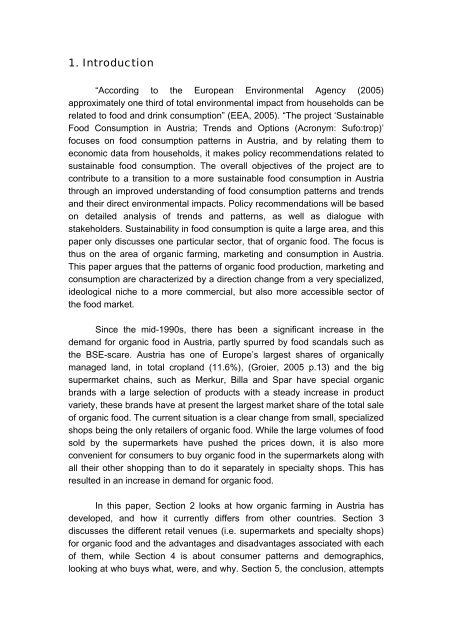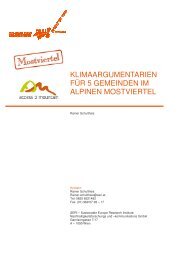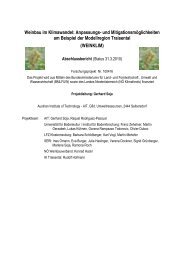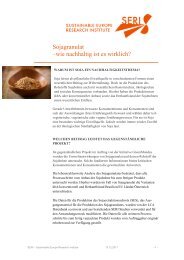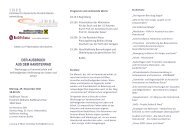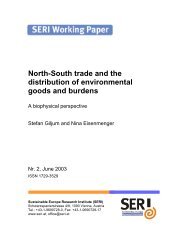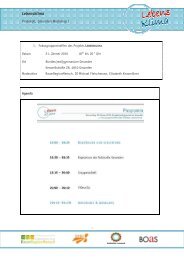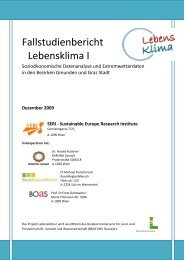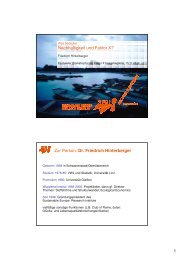Organic food in Austria: Production and Consumption Patterns
Organic food in Austria: Production and Consumption Patterns
Organic food in Austria: Production and Consumption Patterns
Create successful ePaper yourself
Turn your PDF publications into a flip-book with our unique Google optimized e-Paper software.
1. Introduction<br />
“Accord<strong>in</strong>g to the European Environmental Agency (2005)<br />
approximately one third of total environmental impact from households can be<br />
related to <strong>food</strong> <strong>and</strong> dr<strong>in</strong>k consumption” (EEA, 2005). “The project ‘Susta<strong>in</strong>able<br />
Food <strong>Consumption</strong> <strong>in</strong> <strong>Austria</strong>; Trends <strong>and</strong> Options (Acronym: Sufo:trop)’<br />
focuses on <strong>food</strong> consumption patterns <strong>in</strong> <strong>Austria</strong>, <strong>and</strong> by relat<strong>in</strong>g them to<br />
economic data from households, it makes policy recommendations related to<br />
susta<strong>in</strong>able <strong>food</strong> consumption. The overall objectives of the project are to<br />
contribute to a transition to a more susta<strong>in</strong>able <strong>food</strong> consumption <strong>in</strong> <strong>Austria</strong><br />
through an improved underst<strong>and</strong><strong>in</strong>g of <strong>food</strong> consumption patterns <strong>and</strong> trends<br />
<strong>and</strong> their direct environmental impacts. Policy recommendations will be based<br />
on detailed analysis of trends <strong>and</strong> patterns, as well as dialogue with<br />
stakeholders. Susta<strong>in</strong>ability <strong>in</strong> <strong>food</strong> consumption is quite a large area, <strong>and</strong> this<br />
paper only discusses one particular sector, that of organic <strong>food</strong>. The focus is<br />
thus on the area of organic farm<strong>in</strong>g, market<strong>in</strong>g <strong>and</strong> consumption <strong>in</strong> <strong>Austria</strong>.<br />
This paper argues that the patterns of organic <strong>food</strong> production, market<strong>in</strong>g <strong>and</strong><br />
consumption are characterized by a direction change from a very specialized,<br />
ideological niche to a more commercial, but also more accessible sector of<br />
the <strong>food</strong> market.<br />
S<strong>in</strong>ce the mid-1990s, there has been a significant <strong>in</strong>crease <strong>in</strong> the<br />
dem<strong>and</strong> for organic <strong>food</strong> <strong>in</strong> <strong>Austria</strong>, partly spurred by <strong>food</strong> sc<strong>and</strong>als such as<br />
the BSE-scare. <strong>Austria</strong> has one of Europe’s largest shares of organically<br />
managed l<strong>and</strong>, <strong>in</strong> total cropl<strong>and</strong> (11.6%), (Groier, 2005 p.13) <strong>and</strong> the big<br />
supermarket cha<strong>in</strong>s, such as Merkur, Billa <strong>and</strong> Spar have special organic<br />
br<strong>and</strong>s with a large selection of products with a steady <strong>in</strong>crease <strong>in</strong> product<br />
variety, these br<strong>and</strong>s have at present the largest market share of the total sale<br />
of organic <strong>food</strong>. The current situation is a clear change from small, specialized<br />
shops be<strong>in</strong>g the only retailers of organic <strong>food</strong>. While the large volumes of <strong>food</strong><br />
sold by the supermarkets have pushed the prices down, it is also more<br />
convenient for consumers to buy organic <strong>food</strong> <strong>in</strong> the supermarkets along with<br />
all their other shopp<strong>in</strong>g than to do it separately <strong>in</strong> specialty shops. This has<br />
resulted <strong>in</strong> an <strong>in</strong>crease <strong>in</strong> dem<strong>and</strong> for organic <strong>food</strong>.<br />
In this paper, Section 2 looks at how organic farm<strong>in</strong>g <strong>in</strong> <strong>Austria</strong> has<br />
developed, <strong>and</strong> how it currently differs from other countries. Section 3<br />
discusses the different retail venues (i.e. supermarkets <strong>and</strong> specialty shops)<br />
for organic <strong>food</strong> <strong>and</strong> the advantages <strong>and</strong> disadvantages associated with each<br />
of them, while Section 4 is about consumer patterns <strong>and</strong> demographics,<br />
look<strong>in</strong>g at who buys what, were, <strong>and</strong> why. Section 5, the conclusion, attempts


